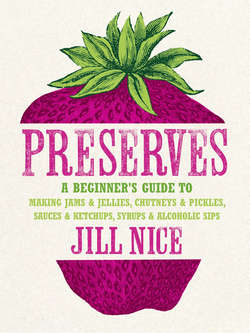Читать книгу Preserves: A beginner’s guide to making jams and jellies, chutneys and pickles, sauces and ketchups, syrups and alcoholic sips - Jill Nice - Страница 6
THE DIFFERENT TYPES OF PRESERVES
ОглавлениеSo, you’ve decided on the main ingredient, but what should you make? And just what is the difference between a jam and a conserve or a chutney and a pickle?
JAM
In its simplest form, jam is fruit boiled with sugar to prolong its keeping quality and prevent it from going mouldy. The effect of heat releases the pectin and acid, present to some degree in all fruit, which then combines with the sugar to form a set. Jam should be a relatively smooth amalgam of fruit and sugar, most usually used for spreading on bread, toast or cakes. In the United States, jam is often referred to as jelly or spread. Jams such as Greengage and Red Gooseberry or Green Tomato Jam with Limes are quite unique.
CONSERVES JAM
Also sometimes referred to simply as preserves, these are pieces of whole fruit suspended in a jellified syrup, for example Cassandra’s Gooseberry Conserve, the truly exotic Fresh Fig Preserve with Sherry or Strawberry Conserve. These are quite delicious and unique and are often eaten as a dessert with cream or used as a filling for sweet flans. Victoria Plum Conserve and Quince and Parsnip Preserve are also utterly delicious and can only be made by your own fair hand.
CURDS
These are usually made from citrus fruits, particularly lemon, in which the pulp, peel and juice are combined with eggs, sugar and butter to give a rich, thick mixture Old-Fashioned Lemon Curd recipe. Lemon curd is a wonderful treat, but without artificial preservatives it does not last well, so make a small quantity and keep it in the fridge. Other fruit, such as raspberries, gooseberries, apricots and peaches, can also be used by substituting 450g fresh fruit, puréed, for the lemon.
CHUTNEYS
A combination of fresh and dried fruit and/or vegetables, hot spices, herbs, sugar and vinegar mixed together to make a chunky mixture in which no flavour predominates. They can range from sweet and mild to ferociously spicy. Chutney should be soft and slightly runny when cooked – the mixture thickens and improves in flavour when kept. In India, the land of its origin, chutney was made with uncooked ingredients and brought to the table raw. Nowadays, it is more usual to set it aside to be eaten at a later date with cold meats and bread and cheese.
Chutney is an excellent way in which to use up gluts of fruit and veg, such as windfall apples, plums, marrows or green tomatoes, that are sometimes less than perfect and correspondingly cheaper or, if you’re really lucky, even free! Tomato Chutney or Hot Rhubarb Chutney make use of glut produce and last throughout the winter to make a good addition to sandwiches and salads.
RELISHES
Relishes are a soft amalgam of fruit and/or vegetables, such as Red Pepper Relish. These delicious goodies are not as long-lasting as chutneys, but they can be made reasonably quickly and are an extremely useful addition to the ubiquitous barbecue menu. Because they spread easily, they are also excellent in sandwiches. Make small pots or keep in the fridge once opened. Hamburgers and sausages will be perked up with the Celery and Tomato Relish or Chilli Relish.
PICKLES
There are three types of pickle. One in which the amount of vinegar used is proportionately lower than the quantity of fruit and sugar, therefore a spicy ‘set’ pickle is achieved. The second type is where fruit and vegetables are partly cooked in a spicy vinegar. The last variety of pickle is made by preparing vegetables in a salt or brine mixture and then packing them into jars of well seasoned vinegar or sauce, for example Pickled Onions or Hot and Spicy Pickled Red Cabbage. Homemade pickles are so much better than commercially produced pickles – no additives, no artificial preservatives – just a wholesome fresh flavour and you can have lots of fun experimenting and even more enjoyment out of the eating!
A pickle like Spiced Gooseberry Pickle can be made throughout the year and adds a welcome boost to a cold supper.
SPICED FRUITS AND FRUITS IN ALCOHOL
Spiced fruits are dried or fresh fruit that have been carefully brought to the boil in a well-spiced vinegar, simmered and then transferred to a jar. The vinegar is then boiled to reduce it, strained and poured, while it is still hot, over the fruit. My favourite fruits to use are Hunza dried apricots Spiced Apricots, prunes and mixed dried fruit. After having been left for a month to mature, they make a very welcome appearance at a festive table.
Alcoholic lovelies are fresh fruit, for example, peaches or greengages, which are gently poached and placed into a jar, covered with syrup and topped up quite extravagantly with alcohol. See Peaches in Brandy Wine, Vivien’s grapes in Muscat, Your own pear liqueur, Sloe Gin and Blackcurrant Shrub.
SAUCES AND KETCHUPS
A preserved sauce is the thick, runny reduction of fruit and/or vegetables cooked with vinegar, sugar and spices; it is then sieved before being bottled. These sauces are most often used as flavourings in soups, sauces and stews. Tomato and Brown Spicy are the most familiar shop-bought sauces. There are some marvellous mixtures, which are very economical to make and last ages. Traditional ketchup (not at all like the popular tomato variety) was at one time a pungent mixture of spices, onions, garlic, occasionally mushrooms and berries, which were allowed to macerate in vinegar for a good length of time before being sieved and bottled. Worcestershire Sauce is the most similar commercial product to a traditional ketchup. Homemade sauces bear no relation to commercial varieties – Spicy Fruit Sauce is a welcome addition to the table, whilst Mushroom Ketchup perks up stews and casseroles.
